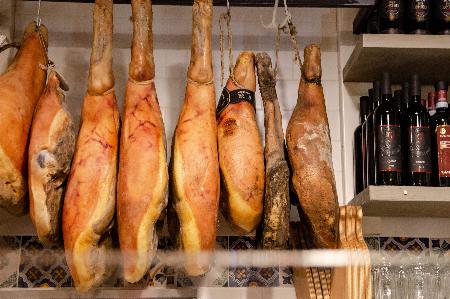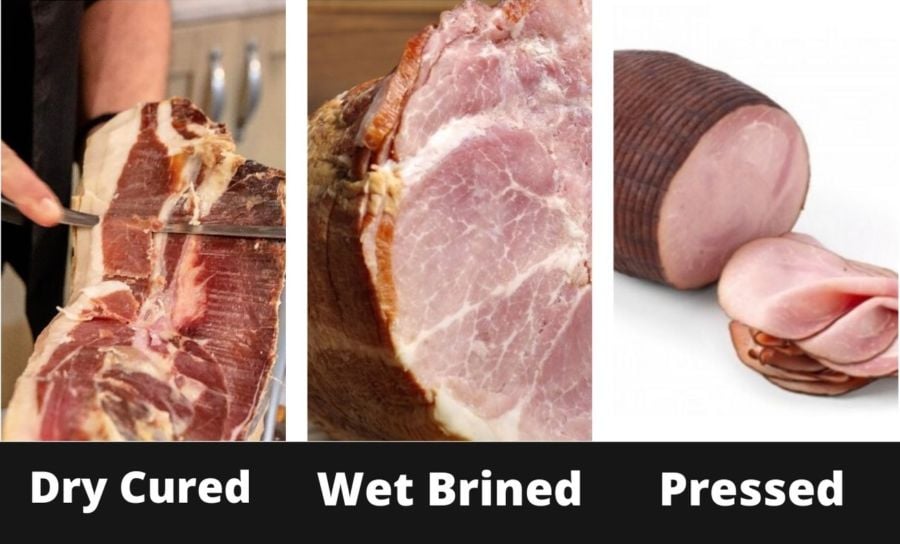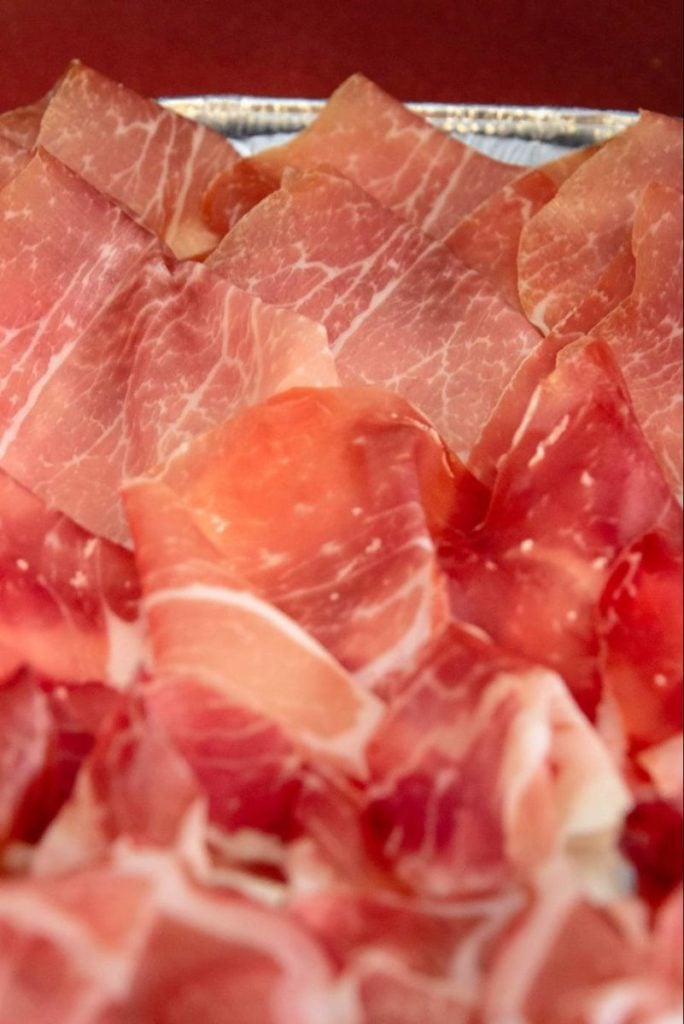You might be looking for a substitute if you can’t find prosciutto at your local market. I will give a breakdown of other options and mention some aspects of why they are good substitutes.
Summary:
Cured Italian Meat Similar to Prosciutto
- Coppa/Capicola/Capocollo: dry cured meat from the upper loin of the pig, often with subtle spicing
- Pancetta: dry-cured pork belly sliced thinly or used for cooking classic dishes like carbonara
- Guanciale: dry cured jowl of the pig; many Italians consider this part the best fat on the pig
- Speck: Central European style of dry-cured meat, cold smoked from either the pork belly or part of the hind leg.
Cured Meats From Other Countries, Like Prosciutto
- Jamon Serrano (Spain): Spanish cured ham typically made from white pigs, known for its rich flavor and firm texture.
- Jamon Iberico (Spain and Portugal): A delicacy made from Iberian pigs, prized for its marbling and unique taste.
- Bayonne Ham (France): French cured ham similar to prosciutto, typically made in the Adour River region.
- Schwarzwälder Schinken (Germany): Also known as Black Forest ham, a smoked and dry-cured ham from the Black Forest region in Germany.
- Kassler (Germany): Cured and slightly smoked cut of pork, often the neck or loin.
Breed of pig, how it was fed and raised and the environment are all variations to these alternatives. Prosciutto and Jaon are
Prosciutto is one of the more refined dry-cured meats since it’s often dried, and flavors develop over the 9 months to 3+ years to create this product. Often, prosciutto takes 12-18 months of curing and drying—also why it’s called ‘dry curing’.
I’ve been savoring and making dry-cured meats for 20-plus years, so I’ll share a few aspects that few know about why dry-cured meats like prosciutto are epic.
So, how do you find an alternative to your favorite cured meat?
Proscuitto is salt and pork crafted carefully and dried for generally, 12 months or more to break down amino acids and develop the depth flavor of quality pork.
Having other well-aged / dried meats is a solid alternative to the prosciutto.
Prosciutto can be substituted for dry-cured meats like Spanish Jamon or other classics like Culatello, Capicola, or pancetta. All these dry-cured meats are produced using a similar process and should be left to dry for over six months to develop depth of flavor.
Genuine Italian prosciutto may be challenging to locate in your local supermarket.
Fortunately, the range of possibilities ensures that everyone may discover an alternative that meets their preferences.
But since dry-cured meats are often a craft that can take months to make the final product, they’re not like other fast-commercial food offerings.

I consider prosciutto a special occasion type fare!
These dry-cured meat alternatives are also epic slow food options, the slowest food around!
Good Substitutes for Prosciutto
When looking for a prosciutto alternative, the substitutions below are relevant for an antipasti board or charcuterie (charcuterie cured meats are expensive, here I wrote why) plate.
The most suitable to the slightly less suitable from top to bottom, I’ll briefly go over each below:
- Serrano Dry Cured Ham
- Culatello
- Iberian Jamon
- Capicola / Coppa
- Pancetta
- Guanciale
- Black Forest Dry Cured Ham
- Coppa/Capicola/Capocollo
- Speck
Serrano Ham
Serrano is an ultra-tasty Spanish ham cured in the open sea air. This prolonged curing process changes the ham, providing a rich taste and fragrance.
Serrano has more taste and less salt than country ham (a USA version of dry-cured pork leg like many of the others below, but often smoked), as well as less fat than prosciutto.

Specific regulations in the USA, mean that the dry-cured Country Ham has a higher salt content, often a cold smoked product, whilst Spanish Serrano, Italian Prosciutto, or French Jambon (all similar, with subtle variations).
However, Serrano ham looks similar to prosciutto since the hind leg of the pig is used. The main difference is that Serrano ham is made from a different breed of pig.
Also, Serrano pigs are often finished on a diet of acorns from oak trees to add a subtleness of nuttiness.
You should use the same amount of serrano ham as you would prosciutto. It may be served sliced paper-thin with cheese and olives, or it can be used to season your favorite hot dishes.
Wrapped around rock melon or sauteed asparagus is also too!
If you talk to an Italian, they will, of course, advise; no substitutions can really be made. However, if you had to here is what I would use.
Thinly Sliced Capicola
Capicola is a seasoned dry-cured pork upper shoulder, the loin area above the shoulder specifically.
Its taste is kind of amazing flavor that is hard to describe, cinnamon, nutmeg, and cloves are often used.
However, the subtleness and combination of these spices create something greater than the sum of the ingredients.
It is made from a spiced pork neck or shoulder that has been sealed, cased, and left to cure for approximately six months.
This is a salumi classic (major dry-cured Italian cuts, which salami is part of also) it may be found in your local deli if you’re lucky!
Because capicola is often sliced for you at the counter, ask for paper-thin slices that are as close as possible to the prosciutto.
Pancetta
Pancetta is a pork belly that has been cured in salt, sugar, and spices such as black pepper, cloves, nutmeg, and cinnamon. (I like to add my own dried ground bay leaf mixture for the homemade type)
Pancetta’s taste makes it a decent substitute for prosciutto. However, since it is from the belly, pancetta has more fat than prosciutto. Quality prosciutto is dried to a point where the fat nearly melts in your mouth like prosciutto. Also, science has been done in Italy that highlights the amino acids of dry-cured meats are easier for our bodies to digest.
Pancetta slabs are often rolled into a log that may be cut to any thickness.
Pancetta is often enjoyed sliced wafer-thin but is also a staple of many classic Italian dishes.
Most supermarkets also sell it pre-sliced or, most typically, chopped into thick cubes for cooking it.
As mentioned, quality pancetta should be savored wafer-thin!
Culatello
Culatello is a well-known and highly valued salumi in Italy. It is created in the province of Parma by curing solely the rear muscles of quality matured pigs.

It’s utilizing the hind leg, deboning it and keeping it in a formed shape.
Culatello has a flavor comparable to prosciutto and is typically served as an appetizer. Though it is more difficult to get, culatello is a fantastic alternative to prosciutto.
Black Forest Ham
Black Forest Ham (Schwarzwaelder Schinken) is a type of cold-smoked dry-cured ham. Again, it is not cooked, it is cured and dried.
The ham is dry salt-cured, cold smoked, and dried like the other dry-cured meats above until the flavor develops and at least 35-45% weight loss is achieved (the weight loss is for the preservation side as well as flavor).
Black Forest ham is an excellent prosciutto alternative and should be used in the same quantities as prosciutto.
There is some confusion and mislabelling, I have seen cooked versions, which should be avoided if you want the authentic stuff.
It should look like this:

Iberian Jamon
A Spanish version of the Italian prosciutto, the unique difference is the indigenous black European pigs are fed a lot of acorns from oak trees.
This gives the dry-cured meat a unique, subtle, nutty flavor.
One of my favorite and most special dry-cured meats, it is often hung to dry and intensifies in flavor up to and above 5 years.
1 year is the minimum to produce this style.
Coppa/Capicola/Capocollo

Coppa, Capicola, or Capocollo (Italy), is a pork-based cured meat spiced to perfection before being sealed, cased, and cured for 6 months (or more).
Please do note, however, that in some Italian regions, this meat is dry-smoked rather than cured, though the curation process is what really gives it its historical flavor and appeal.
This cut of meat is from the upper shoulder/neck region of the pig and tends to be leaner than other types of cured meats, though it is fattier than the classic prosciutto.
Coppa/capicola/capocollo is marketed differently depending on the region. Generally, it is sold based on the “flavor” imparted by the various herbs used in its preparation.
For example, if cinnamon is common, it could be sold as a “sweet” variety—more common in the US. Traditional coppa does not have sugar added.
Coppa/capicola/capocollo is sliced very thinly, though you can see its bright red coloration and cream-colored fat marbling throughout. It is a great choice to substitute (or pair with) prosciutto on a charcuterie board for your upcoming social event.
Guanciale
Guanciale is one of the fattiest cured meats on this list.
I’ve made many variations, however. It’s from the pig’s jowl; many Italians consider this one of the tastiest cuts of meat. It is the traditional ingredient for authentic carbonara.
Speck
Speck is another cured meat similar to prosciutto, though it is usually sliced even thinner- but it can be served similarly. This cured meat option also has Italian and European roots.
The cut of meat that speck comes from is most often its hind legs, which usually provides it with a more meaty portion compared to the fat that is attached. Speck is also unique in its curation process. Not only is it prepared with loads of unique spices that add flavor to this option, but it is also a commonly smoked meat.
Either sliced thinly or used in the kitchen, Speck has slight variations in Germany and other countries in Europe, and it can be found often.
What Is Prosciutto?
Prosciutto is produced from high-quality pork legs. The meat is salted and allowed to sit for a few weeks, sometimes a month or so.
This theory is also applied to all the substitutes above.
During this period, the salt binds and diffuses, reducing the unwanted bacteria. It’s all about disrupting the water activity in the meat, and salt is the absolute key to this.
This also causes the flavors to become more concentrated after the long drying process.
Prosciutto is thinly sliced; the wafer-thin slicing greatly impacts perceived saltiness. A deli slicer is very important since few trained professionals can slice cured meats ultra-thin.
Or buy it or get it sliced wafer-thin!
You can buy whole chunks of prosciutto, but you won’t get the desired results unless you have a precise deli slicer (often weighing 30 pounds/15kg plus).
What Does Prosciutto Taste Like?
Prosciutto is subtly sweet and salty – but as mentioned, the thin slicing balances the saltiness.
Also, there are many variations of Prosciutto worldwide and even in Italy. In Italy, I would say there are dozens of types across regions.
One of the classics, Prosciutto Parma Ham, is strictly protected by law. The whole process, from the rearing of the pig to the type of pig, is strictly controlled. It has two ingredients: pork and Salt.
Prosciutto can have a massive range from salmon pink to brownish-red, and each slice is marbled with fat.
Some types of prosciutto (Here is something I wrote about the shelf life of prosciutto also) are seasoned with spices and herbs such as black pepper, garlic, juniper, and rosemary, which gives it a more distinct, aromatic flavor.
It isn’t a traditional prosciutto if it has more than Salt and Pork
The more time prosciutto matures, the more nuanced it tastes. There are 2-3-year-old prosciutto made with care and passion across Italy.
Prosciutto can be served on its own or with fruit, vegetables, bread, cheese, and wine. It is also used in cooked recipes such as pizza and pasta.
Summary
While they cannot replace prosciutto, the alternatives in this article will be solid.
Many cured meats can be a replacement, but they do not provide the same feeling.
Sources:
My decades of meat curing, teaching, making, and eating experience, plus some research, was done for this.
https://www.tienda.com/learn-about-spain/jamon.html
https://www.eataly.com/us_en/magazine/culture-and-tradition/what-is-prosciutto

Tom Mueller
For decades, immersed in studying, working, learning, and teaching the craft of meat curing, sharing the passion and showcasing the world of charcuterie and smoked meat. Read More
